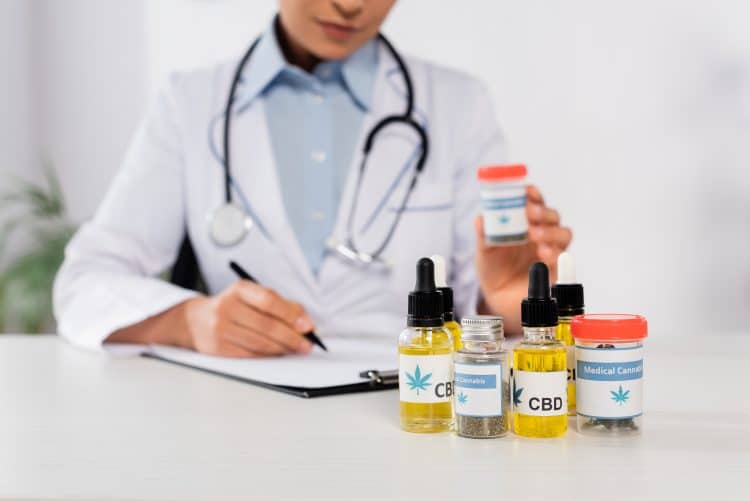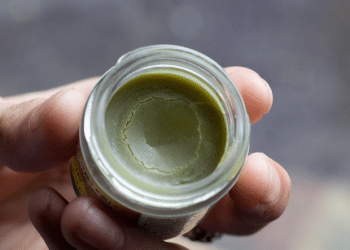The human endocannabinoids in each of our bodies have been discovered to correspond to other exogenous cannabinoids from plants like cannabis. It’s the endocannabinoid system–or ECS– that makes possible the interaction of phytocannabinoids with cannabinoid receptors then reap the potential psychoactive or therapeutic effects on our bodies. [1]
There’s quite a few ways to get those important cannabinoid compounds activated in your body and in unison with your own ECS, however there are big differences in their administration and consumption everyone should be up-to-date on.
Smoking Cannabinoids
An ancient Eurasian shaman gets buried with 800 grams of high-tetrahydrocannabinol (THC) cannabis around 750 B.C. near the Flaming Mountains of China. Several millennia later archeologists find the buried shaman and his well-preserved dried cannabis buds. This is one of the first actual physical discoveries of cannabis prepared to be smoked found in the world. [2]
People have been smoking cannabis for a very long time, but it seems the more ways there are to smoke it now, it’s all still relatively the same dried female flower that the shaman was smoking as well. The main idea is to apply heat to the dried bud and find a way to inhale the resulting cannabinoid-rich smoke. Combustion at around 1220°F or higher is necessary to do so. [3]
Instruments like glass and metal bowls and rolling papers for all sizes and shapes have been around for a long time and are still the main ways that people fire up their cannabis. Their popularity continues to this day in forms such as glass bongs, blunts, and pre-rolled cones. Smoking accessories similar to these are some of the first ways cannabis was consumed, and still continue on in popularity.
Vaping Cannabinoids
Vaping has risen in popularity over the last 10 or so years as a result of availability and convenience. This particular method of administration is when the heat source temperature is just slightly below the temperatures used for combustion and smoking cannabis.
This lower level of heat from a result of electricity or battery-powered heat coils and ceramic ovens creates cannabinoid-rich vapor from the dried cannabis flower or concentrate-based hash oil starting with a temperature as low as 356-376°F however most people vape at a temperature that can reach very high levels that border more on the side of combustion instead. [4]
Vape Cartridges
Due to outlying factors like being discreet, convenient, readily available, and affordable, vape cartridges have become the standard for many cannabis consumers, much to the dismay of health officials and researchers due their often mysterious compositions. [4]
However, it’s not always just the cannabis extracts and oils that can sometimes contain adulterants themselves that can lead to potential adverse health effects. It’s also the harmful effects that the act of vaping itself can have on the lungs, respiratory system, and bronchioles that are of concern. [6]
Dry Herb Vaporizers are Recommended
Studies show that using a dry herb vaporizer such as a Volcano, can produce “therapeutically active cannabinoid vapors, but below the point of combustion where noxious pyrolytic byproducts were formed.” [5] Health-conscious reasons like that, along with the lack of any adulterants are why many health officials and experts consider dry herb vapes a top alternative to smoking cannabis or using vape cartridges.
Edibles
Eating your cannabis to derive effects from the cannabinoids has been popularized by numerous treats like brownies, cookies, gummies, and others. These are created in conjunction with a cannabinoid-rich extract of a carrier oil (olive, MCT coconut, avocado) or butter in their recipes.
Edibles as they are popularly known, have taken society by storm–everyone from celebrities to your next-door neighbor have tried them out. Unlike smoking or vaping, the edibles must be digested so that the cannabinoids can reach the bloodstream to take effect.
Since smoking and vaping give way to immediate effects they can be very convenient for that reason, while on the other hand ingesting edibles can take as long as your specific metabolism takes to digest them.
Edibles and Decarboxylation
To create these types of cannabinoid delivery systems, the cannabis must first be activated by a heat source–just like smoking and vaping–but performed differently. The act of decarboxylation is applying heat to dried cannabis in a covered container inside the oven or decarboxylation device somewhere in the range of 220-250°F for 30-60 minutes. [7]
This will activate the cannabinoids by removing a carbon atom from their molecular structure. The activated cannabis can then be infused with warm oil or butter for several hours to produce the ingredients necessary to create edibles.
Here are some other delivery methods that can found in an edible form:
- Tinctures are born of a union of any of the aforementioned carrier oil types or grain alcohol and decarboxylated cannabis, tinctures are essentially a liquid that can be placed under the tongue for a quicker sublingual effect. Tinctures are popular due to their lack of any other ingredients like sugar, chocolate, gelatin, etc that are found in most common edible forms.
- Sprays are sublingual sprays that are also created by extracting a concentrate of cannabis from decarboxylation and infusing them with a solvent like alcohol into a spray bottle for super convenient administration of activated cannabinoids.
- Capsules are typically made from infused MCT cannabis oil that is inserted into a pill capsule with a dropper or syringe. These are also popular for their no-nonsense consistency and convenient, discreet sizes.
- Topicals, though not edible at all, are also infused oil, but mixed with lotion or shea butter products that are used by many people for their simple application and pain relief potential. These products seem to have a consensus that there is no psychoactive “high” when applied to the pain areas on the skin, since the decarboxylated oil they are derived from cannot break the skin’s blood barrier in humans. It is instead able to penetrate sore muscles and joint tissue. However, according to some researchers, there still needs to be more studies done to confirm this claim [8].
Cannabis Concentrates & Dabs
Concentrated forms of cannabis have seen a huge rise in popularity, despite being around in more simple forms for a long time. Hashish is essentially concentrated cannabis extract made from cannabis flower pollen and pressed together by a low heat source and/or pressure.
Hash has been smoked and consumed by people for thousands of years, but only recently have we seen cannabis culture embrace it so heavily in newer, more versatile forms. Many of these concentrates are created by several different extraction processes.
Dabbing
Dabs are extremely concentrated vapor clouds that are inhaled by the consumer in a dab rig or other vape device for a very intoxicating and concentrated effect. Heat is often applied by a handheld mini butane torch, lighter, or electronic device to the concentrated hash or bowl containing it.
Modern dabbing devices such as e-rigs, portable vaporizers, and glass dab rigs are capable of efficiently handling the application of heat sources needed to “dab” or consume any of the following very potent and sticky formulations that are found in most dispensaries and dab rigs in the U.S.:
Get Your Cannabinoids Administered Properly
The lack of a heat source will not allow cannabinoids to be activated in a manner that will work synergistically with the body’s own endocannabinoid system in order to get the potential effects that are being sought. Retail products like edibles and topicals will already be activated and ready for immediate application, while products like concentrates and dried flower will need the consumer to apply the heat themselves.
However you consume or use cannabis or cannabis products, the main idea is to get your brain’s cannabinoid receptors to receive the psychoactive or therapeutic effect you desire in an efficient manner that also works for your lifestyle, preferences, and pocketbook.
References:
[1] Crocq, M. A. (2020). History of cannabis and the endocannabinoid system. Dialogues in Clinical Neuroscience, 22(3), 223-228. https://doi.org/10.31887/DCNS.2020.22.3/mcrocq
[2] Russo, E. B., Jiang, H. E., Li, X., Sutton, A., Carboni, A., Del Bianco, F., … & Li, C. S. (2008). Phytochemical and genetic analyses of ancient cannabis from Central Asia. Journal of experimental botany, 59(15), 4171-4182.
[3] K. O’Brien Fehr and H. Kalant. 1972. Analysis of Cannabis Smoke Obtained under Different Combustion Conditions. Canadian Journal of Physiology and Pharmacology. 50(8): 761-767. https://doi.org/10.1139/y72-111
[4] Aston, E. R., Farris, S. G., Metrik, J., & Rosen, R. K. (2019). Vaporization of marijuana among recreational users: A qualitative study. Journal of Studies on Alcohol and Drugs, 80(1), 56-62. https://doi.org/10.15288/jsad.2019.80.56
[5] Tashkin, D. P. (2015). How beneficial is vaping cannabis to respiratory health compared to smoking?. Addiction (Abingdon, England), 110(11), 1706-1707.
[6] Gieringer, D., St. Laurent, J., & Goodrich, S. (2004). Cannabis Vaporizer Combines Efficient Delivery of THC with Effective Suppression of Pyrolytic Compounds. Journal of Cannabis Therapeutics, 4(1), 7–27. https://doi.org/10.1300/J175v04n01_02
[7] Wang, M., Wang, Y. H., Avula, B., Radwan, M. M., Wanas, A. S., van Antwerp, J., Parcher, J. F., ElSohly, M. A., & Khan, I. A. (2016). Decarboxylation Study of Acidic Cannabinoids: A Novel Approach Using Ultra-High-Performance Supercritical Fluid Chromatography/Photodiode Array-Mass Spectrometry. Cannabis and cannabinoid research, 1(1), 262–271. https://doi.org/10.1089/can.2016.0020
[8] Patel, P. M., & Lio, P. A. (2021). Safety and Sourcing of Topical Cannabinoids: Many Questions, Few Answers. The Journal of clinical and aesthetic dermatology, 14(8), 49–51.












